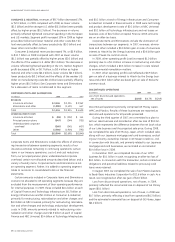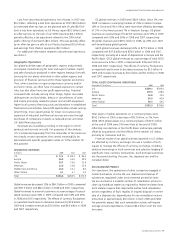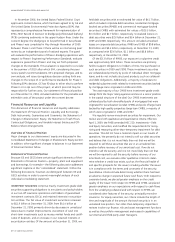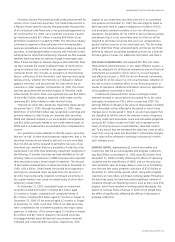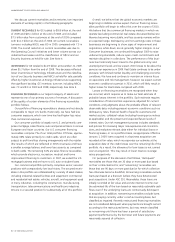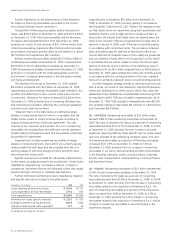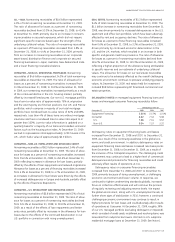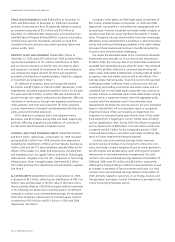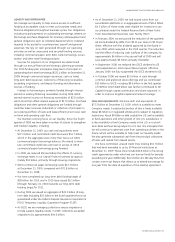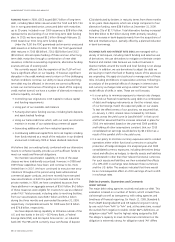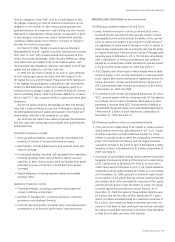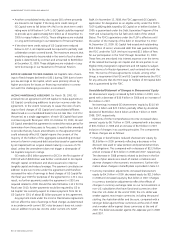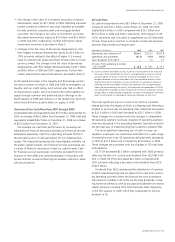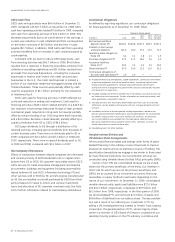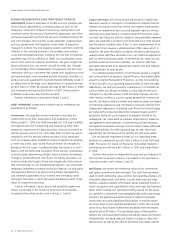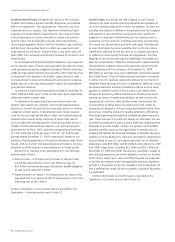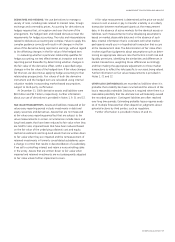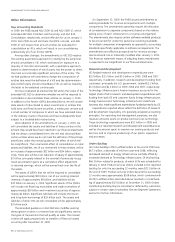GE 2009 Annual Report Download - page 50
Download and view the complete annual report
Please find page 50 of the 2009 GE annual report below. You can navigate through the pages in the report by either clicking on the pages listed below, or by using the keyword search tool below to find specific information within the annual report.’
48 GE 2009 ANNUAL REPORT
FUNDING PLAN. In 2009, GECS issued $69.7 billion of long-term
debt, including $46.5 billion issued under the TLGP and $23.2 bil-
lion in non-guaranteed senior, unsecured debt with maturities
up to 30 years. Included in our 2009 issuances is $38 billion that
represents the pre-funding of our 2010 long-term debt funding
plan. In 2010, we have issued $5.1 billion (through February 15,
2010) toward our 2011 long-term funding plan.
Under the TLGP, the FDIC guaranteed certain senior, unsecured
debt issued on or before October 31, 2009. Our TLGP-guaranteed
debt matures in 2010 ($6 billion), 2011 ($18 billion) and 2012
($35 billion). We anticipate funding of these and our other long-
term debt maturities through a combination of new debt
issuances, collections exceeding originations, alternative funding
sources and use of existing cash.
We currently expect that the expiration of the TLGP will not
have a significant effect on our liquidity. If, however, significant
disruption in the credit markets were to return or if the challenging
market conditions continue, our ability to issue unsecured long-
term debt may be affected. In the event we cannot sufficiently
access our normal sources of funding as a result of the ongoing
credit market turmoil, we have a number of alternative means to
enhance liquidity, including:
• Controlling new originations in GE Capital to reduce capital
and funding requirements
• Using part of our available cash balance
• Pursuing alternative funding sources, including bank deposits
and asset-backed fundings
• Using our bank credit lines which, with our cash, we intend to
maintain in excess of our outstanding commercial paper
• Generating additional cash from industrial operations
• Contributing additional capital from GE to GE Capital, including
from funds retained as a result of the reduction in our dividend
announced in February 2009 or future dividend reductions
We believe that our existing funds, combined with our alternative
means to enhance liquidity, provide us with sufficient funds to
meet our needs and financial obligations.
We maintain securitization capability in most of the asset
classes we have traditionally securitized. However, in 2008 and
2009 these capabilities have been, and continue to be, more
limited than in 2007. We have continued to execute new secu-
ritizations throughout this period using bank administered
commercial paper conduits, and more recently have executed
new securitizations in both the public term markets and in the
private markets. In 2009, we have completed issuances from
these platforms in an aggregate amount of $14.0 billion. $4.3 billion
of these issuances were eligible for investors to use as collateral
under TALF. Total proceeds, including sales to revolving facilities,
from our securitizations were $18.7 billion and $71.4 billion
during the three months and year-ended December 31, 2009,
respectively. Comparable amounts for 2008 were $17.8 billion
and $76.8 billion, respectively.
We have deposit-taking capability at 18 banks outside of the
U.S. and two banks in the U.S. — GE Money Bank, a Federal
Savings Bank (FSB), and GE Capital Financial Inc., an industrial
bank (IB). The FSB and IB currently issue certificates of deposit
(CDs) distributed by brokers in maturity terms from three months
to ten years. Bank deposits, which are a large component of our
alternative funding, were $38.9 billion at December 31, 2009,
including CDs of $17.7 billion. Total alternative funding increased
from $55 billion to $57 billion during 2009, primarily resulting
from an increase in bank deposits mainly from the acquisitions of
BAC and Interbanca S.p.A., partially offset by a planned reduction
in bank borrowings.
EXCHANGE RATE AND INTEREST RATE RISKS are managed with a
variety of techniques, including match funding and selective use
of derivatives. We use derivatives to mitigate or eliminate certain
financial and market risks because we conduct business in
diverse markets around the world and local funding is not always
efficient. In addition, we use derivatives to adjust the debt we
are issuing to match the fixed or floating nature of the assets we
are originating. We apply strict policies to manage each of these
risks, including prohibitions on speculative activities. Following is
an analysis of the potential effects of changes in interest rates
and currency exchange rates using so-called “shock” tests that
model effects of shifts in rates. These are not forecasts.
• It is our policy to minimize exposure to interest rate changes.
We fund our financial investments using debt or a combination
of debt and hedging instruments so that the interest rates
of our borrowings match the expected yields on our assets.
To test the effectiveness of our positions, we assumed that,
on January 1, 2010, interest rates increased by 100 basis
points across the yield curve (a “parallel shift” in that curve)
and further assumed that the increase remained in place for
2010. We estimated, based on the year-end 2009 portfolio
and holding all other assumptions constant, that our 2010
consolidated net earnings would decline by $0.1 billion as a
result of this parallel shift in the yield curve.
• It is our policy to minimize currency exposures and to conduct
operations either within functional currencies or using the
protection of hedge strategies. We analyzed year-end 2009
consolidated currency exposures, including derivatives desig-
nated and effective as hedges, to identify assets and liabilities
denominated in other than their relevant functional currencies.
For such assets and liabilities, we then evaluated the effects
of a 10% shift in exchange rates between those currencies
and the U.S. dollar. This analysis indicated that there would
be an inconsequential effect on 2010 earnings of such a shift
in exchange rates.
Debt Instruments, Guarantees and Covenants
CREDIT RATINGS
The major debt rating agencies routinely evaluate our debt. This
evaluation is based on a number of factors, which include finan-
cial strength as well as transparency with rating agencies and
timeliness of financial reporting. On March 12, 2009, Standard &
Poor’s (S&P) downgraded GE and GE Capital’s long-term rating
by one notch from “AAA” to “AA+” and, at the same time, revised
the outlook from negative to stable. Under S&P’s definitions, an
obligation rated “AAA” has the highest rating assigned by S&P.
The obligor’s capacity to meet its financial commitment on the
obligation is extremely strong. An obligation rated “AA” differs


